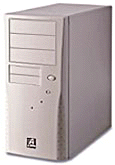[ The PC Guide | Systems and Components Reference Guide | System Case | Form Factors ]
ATX / Mini ATX / Extended ATX Form Factor
The first significant change in case and motherboard design in many years, the ATX form factor was invented by Intel in 1995. ATX and its variants have now become the industry standard in most segments of the market, replacing the former reigning champion, Baby AT. The ATX design has several significant advantages over the older designs, but the enormous installed base of existing Baby AT cases and motherboards has caused the change to ATX to take many years.
The ATX case is similar to a Baby AT case except that the holes in the back are altered to fit the changed design of the ATX form factor motherboard, in particular the integrated I/O ports. In most cases a user-replaceable I/O template is used to allow different configurations of I/O ports installed directly on the motherboard. The ATX case also uses a different, ATX power supply, which is also used for NLX form factor cases. Most ATX cases have more features than AT cases because they are newer, and they are sometimes more expensive for the same reason, though this is less common now that AT case production has dropped in volume. The advantages of the ATX design are discussed in the form factor chapter on motherboards. More information on the ATX form factor as it relates to power supplies can be found here. You can also find detailed specifications about ATX and other newer form factors at the Platform Development Support Web Site.
Millions of older Baby AT systems are in existence, and to make it easier for their
owners to upgrade gradually to the ATX form factor, many high-quality ATX cases will also
accommodate Baby AT motherboards. (Having a case that can handle either form factor
motherboard also makes production easier for the manufacturer.) Sometimes additional
hardware (often just a new I/O template) or slight modifications are needed to the case to
switch from Baby AT to ATX or vice-versa.
|
This classically-styled mid tower case can handle |
Image � 1999 AOpen |
Intel has also specified a "Mini ATX" motherboard size, which is slightly smaller than the full-sized ATX specification. These boards use the same ATX form factor power supplies and cases. The main difference is that full ATX motherboards have a maximum size of 12"x9.6", and Mini ATX boards have maximum dimensions of 11.2"x8.2".
You may also come across motherboards, particularly high-end models used in performance workstations or servers, that use the "Extended ATX" form factor, also sometimes called "EATX". This form factor is essentially the same as ATX, except that the board can be up to 12"x13" in size. These boards are uncommon, and the Extended ATX form factor is likely to receive significant competition from the new WTX form factor, which was designed especially for workstations. The larger motherboard size means that special Extended ATX cases are generally required.
The different form factors in the ATX family are similar, and the biggest differences
between motherboards of different ATX-style form factors are dimensions, and the placement
of mounting holes. This means that most cases are "downward compatible" with the
smaller ATX variants, as long as they have provided appropriate sets of places to put
mounting hardware. If a case will support installation of a full-sized ATX motherboard, it
may also support a Mini ATX, microATX or FlexATX board as long as the designers of the
case have taken the smaller form factor variants into consideration.
![]() Next: microATX and FlexATX Form Factor
Next: microATX and FlexATX Form Factor
| The PC Guide
(http://www.PCGuide.com) Site Version: 2.2.0 - Version Date: April 17, 2001 © Copyright 1997-2004 Charles M. Kozierok. All Rights Reserved. |
Not responsible for any loss resulting from the use of this site. Please read the Site Guide before using this material. |
